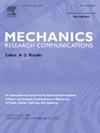基于修正临界平面能量-能量梯度的光滑/缺口试件多轴疲劳寿命预测模型
IF 2.3
4区 工程技术
Q3 MECHANICS
引用次数: 0
摘要
基于能量的临界平面法在多轴疲劳寿命预测中得到了广泛的认可,但传统的实现方法由于过于简化的应变能密度计算,从根本上限制了精度。将改进的应变能计算方法与临界面准则相结合,建立了一种同时适用于光滑和缺口试件的通用预测模型,其中临界面由最大损伤参数确定。在该模型中,根据临界平面上的能量分布定义了能量梯度影响系数的概念,以考虑缺口的影响。利用GH4169、TC4和Al7050-T7451合金的有限元分析(FEA)和实验数据对模型进行验证和比较。定量评价表明,与传统的基于能量的模型(SWT、CXH和CCB)相比,该模型具有更高的预测精度,特别是当材料产生塑性应变能时。本文章由计算机程序翻译,如有差异,请以英文原文为准。
A modified critical plane energy–energy gradient based multiaxial fatigue life prediction model for smooth/notched specimens
The energy-based critical plane method has gained considerable acceptance in multiaxial fatigue life prediction, but conventional implementations fundamentally limit accuracy through oversimplified strain energy density computations. By combining the modified strain energy computation approach and critical plane criterion, a general prediction model that applicable to both smooth and notched specimens is established, in which the critical plane is determined by the maximum damage parameter. In the proposed model, the concept of energy gradient influence coefficient in terms of the energy distribution on the critical plane is defined to account for the influence of the notch. For model verification and comparison, finite element analysis (FEA) and the experimental data of GH4169, TC4 and Al7050-T7451 alloys are utilized. Quantitative evaluation shows that the proposed model has superior prediction accuracy compared to conventional energy-based models (SWT, CXH and CCB), especially when the materials generate plastic strain energy.
求助全文
通过发布文献求助,成功后即可免费获取论文全文。
去求助
来源期刊
CiteScore
4.10
自引率
4.20%
发文量
114
审稿时长
9 months
期刊介绍:
Mechanics Research Communications publishes, as rapidly as possible, peer-reviewed manuscripts of high standards but restricted length. It aims to provide:
• a fast means of communication
• an exchange of ideas among workers in mechanics
• an effective method of bringing new results quickly to the public
• an informal vehicle for the discussion
• of ideas that may still be in the formative stages
The field of Mechanics will be understood to encompass the behavior of continua, fluids, solids, particles and their mixtures. Submissions must contain a strong, novel contribution to the field of mechanics, and ideally should be focused on current issues in the field involving theoretical, experimental and/or applied research, preferably within the broad expertise encompassed by the Board of Associate Editors. Deviations from these areas should be discussed in advance with the Editor-in-Chief.

 求助内容:
求助内容: 应助结果提醒方式:
应助结果提醒方式:


